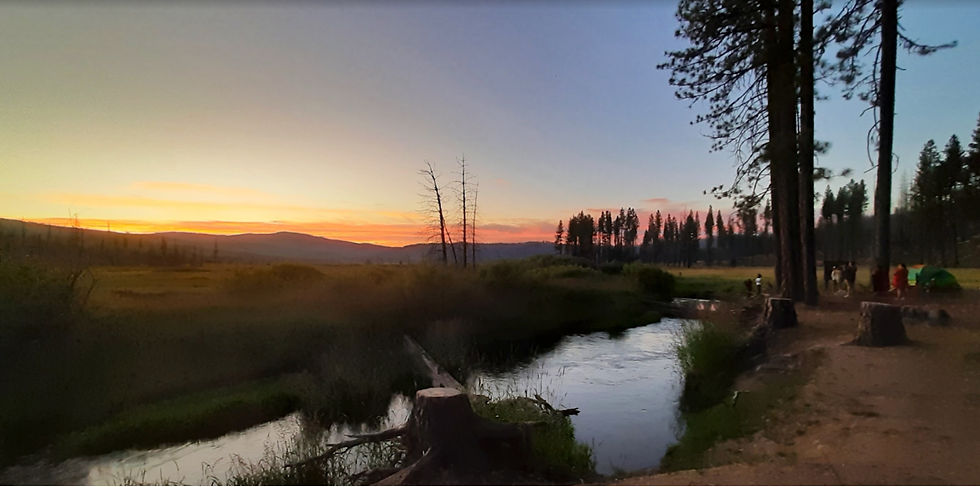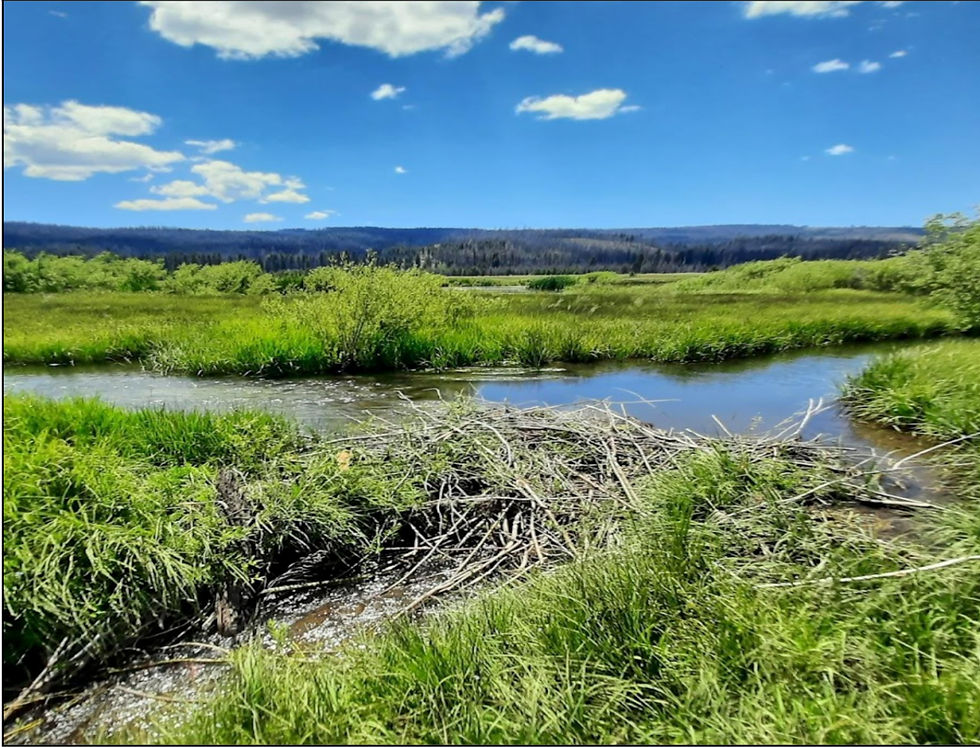Feather River Advocacy Project: Lessons in Resilience from Tásman Kóyom
- Redbud Resource Group

- Aug 27
- 7 min read
A journey of restoration, reconnection, and a land coming back to life.
By Crystal Brown, Project Coordinator, Feather River Advocacy Project
The Road In

The road into Yellow Creek Campground is long and dusty, winding through conifer woodlands and little meadows. As we drove in, my eyes caught on a shade structure standing off to the side, made from sturdy tree poles, with willow woven overhead. A few signs stood nearby, likely telling the story of this place. I thought to myself, I’ll have to stop here and check it out later.
Most of our participants arrived by route along Hwy 70, following K'odojampem Bom (The Worldmakers Trail) , an existing tour we tailored earlier this year to fit the Feather River Advocacy Project. The guide invited them to pause at various stops woven into our creation stories, offering a chance to see the land through the eyes of our ancestors.

For some, these were places they’ve known all their lives. For others, the connection is there but has been thinned by distance, time, and the disruptions that have scattered our people. I count myself among the latter. My ties to this side of the mountain run deep, but for much of my life, they’ve lived quietly in my blood rather than in my footsteps. Learning some of our old stories along this trail felt deeply healing, like waking up a part of myself that had been sleeping for a very long time.
We wrapped up our travels into Greenville with lunch at Roundhouse Council. As we gathered around to rest and eat, Mary Joseph spoke about her work guiding Mountain Maidu youth through various stages of their growth, weaving cultural teachings into their journey to keep them grounded in who they are. She spoke with the kind of strength that comes from living the teachings she shares. Listening to her, we felt deeply inspired by the ways Roundhouse Council is helping young people stay rooted in their identity while finding their way in today’s world.
Willow Teachings

We began our weekend beside Yellow Creek in Tásmam Koyóm, one of the main tributaries of the Feather River. The water here is ice cold, and can heal even the deepest of wounds if you allow it. Just a few months earlier, a cultural burn had been carried out here hosted by the Maidu Summit Consortium. Walking the site, following Ben Cunningham, we saw how beautifully the land had rejuvenated. You could hardly tell fire had touched it at all. The grasses had sprung back, the willows were green, and the medicines poked their heads out to greet us.
We spent a little time in the early afternoon working together to deadhead a willow patch within the burned area along the riparian zone. It was quiet, simple work, the kind that gives you time to notice the details: the way the creek bends, a deer grazing across the creek, the way conversation and laughter flows easily when hands are busy. This act of care felt grounding, a reminder that tending the land connects us not only to our cultural resources but to each other. While I worked, I thought about the children of Roundhouse Council. Perhaps one day, they will gather willow here for a weaving lesson.
Hello again Beaver!
For the past five years, the Maidu Summit Consortium, and their trusted partners, has been working to restore this watershed by reintroducing beavers. Beavers are relatives who were driven out during the fur trade and Gold Rush. Their return is helping to heal the ecosystem they once helped shape for many generations.

I will never forget the stark contrast we saw that day. On one side of the road, where cattle had grazed and no restoration had taken place, the creek ran bare and exposed, without shade. The banks were steep and eroded, with little to no plant life holding the soil in place. The water moved through tiredly with nowhere to rest. But just across the bridge, in the section Maidu Summit Consortium had been restoring, the difference was astounding. Willows, sedges, and other riparian plants grew thick and green along gently sloping banks. Birds darted through the air, and the creek sang with the hum of life. In just a few yards, the land told two entirely different stories: one of extraction, and one of reciprocity.
A short walk through the tall grasses brought us to a natural beaver dam, built by the world’s most resourceful architects. Ben explained that about twenty-three ponds had been dug out during the reintroduction process. The beavers quickly made them home, building dams to divert the creek and fill the ponds. Though cottonwood is their preferred building material, plantings here hadn’t taken hold at first, so they turned to willow, the one resource that had flourished.
In that choice, Beaver teaches us resourcefulness. They remind us that resilience doesn’t require perfect conditions. It’s about working with what’s in front of you and shaping it into a home, a future, and a thriving place.

From there, Ben led us to the man-made beaver analogs (structures designed to mimic natural beaver dams and help the wetland heal). The journey involved a hike and a trek through marshland, and I was impressed by how effortlessly he moved through it all. Quiet and observant by nature, Ben carried the steady presence of a strong leader. He walked with the confidence of someone who knew every bend, every tuft of grass, every hidden puddle. He didn’t need to explain where we were going; he just set off, and we trailed behind like kids trying to keep up. He knew this land like a close relative.
He led us onto a trail filled with water, walking ankle-deep through the clear stream until he stopped in a spot that seemed to be the end of the trail. At first, I searched for what he wanted to show us, waiting for him to part the willow and reveal a whole beaver village or something. I quickly realized we had been walking through the magic the whole time. The entire walk was the thing he wanted us to see.

The land was alive! Brimming with water, thick with plants, alive with unfamiliar insects, and filled with the songs of birds. The analogs built here had transformed the landscape into a thriving biodiverse ecosystem, holding water and soil in place and keeping excess sediment from washing into the Feather River below.
Standing there, I felt the weight of the moment settle into me like the soggy earth beneath my feet. Excitement rose first. Gratitude that such a place could exist, so alive and healed! Then came the ache. Sadness for the places still waiting, thirsty for this kind of care. And woven through it all, a bittersweet current: hope in what is possible when we intentionally choose to tend the land collaboratively, and a sobering knowing of the long road still ahead.
The children with us brought me back to the present. They splashed and played in the water, their laughter carrying through the marsh. One young boy had brought his fishing pole and was proudly catching fish along the way, tucking them into his pockets like Pokémon cards. We all loved that for him. Their joy was contagious. It was a living reminder that restoration isn’t only about science and stewardship, but about creating places where life, in all its forms, can flourish for generations to come.
Spring Forward
That concluded Ben’s tour, but a handful of us weren’t quite ready to call it a day. We had one more stop in mind: the magical spot where the water literally bursts from the ground. A natural spring spilled into a wide, wet meadow, embraced by towering conifers scorched by fire, dotted with rejuvenated herbs and chaparral, before wandering off to join Yellow Creek. The water here is glacier-level cold! Fresh from the earth, no filter needed.
We took turns filling our jugs, hands instantly frozen. Then, following tradition, we washed ourselves in the clear, cold water. Some of us plunged in completely, emerging with the wide-eyed look of someone whose soul just left their body and came back cleansed. Others went for the “arms and face” method. It was a little less dramatic, but still enough to feel it in your bones.
That’s when Magan Herrera, one of our Indigenous herbalists, spotted a big stand of Fireweed growing along the trail. She stepped up like she was introducing an old friend, sharing its name, its healing gifts, and how to harvest it respectfully. We gathered just a small amount, careful not to overstay our welcome.

For me, this was a moment of deep reconnection. I offered a song so the land would know who I am, and to say thank you for having us. The land responded with a soft breeze and a generous offering of Fireweed.
The Road Out
By the time we returned to camp, the sun had softened and the air was beginning to cool. We sank into a well-earned rest. Smiling at our day.
When it was finally time to head home, I decided to stop at the shade structure I had noticed
when I first arrived. Standing beneath the woven willow, I felt its cool shelter- a small but intentional act of care for all those who pass through. The signs there told a story of community, history, and resilience. At my feet, a mineral spring bubbled up through a man‑made basin in the ground. One last gift for the road.
I realized this little shelter mirrored our work here in a way: creating places where people can pause, rest, and be reminded of their relationship to the land and people.

That feels like the spirit of the Feather River Advocacy Project. Making space. Slowing down enough to notice our callings to come home, heard subtly in the stories of elders, or written quietly in the river’s flow. It’s about tending to the relationships with the water, with the land, and with one another, so that when the people are ready to come home, the land is prepared to give generously to all, as she once did long ago.
To learn more about the Feather River Advocacy Project, you can follow us on social media @redbudresourcegroup and read more about our programming on our website:







Comments